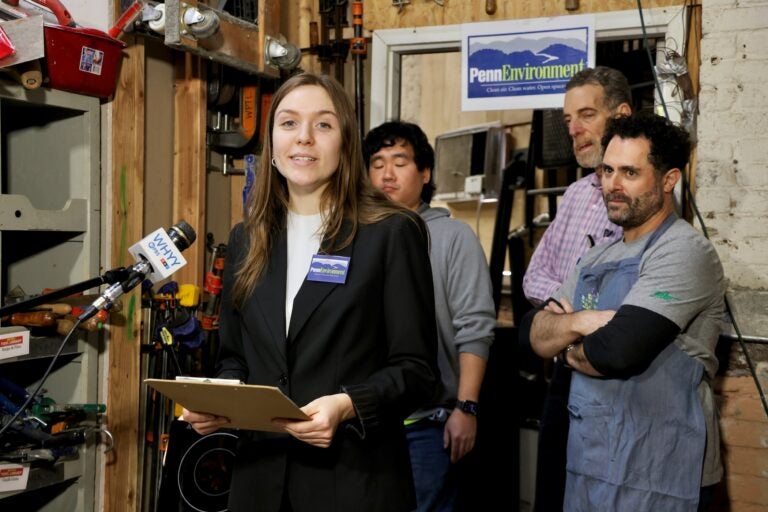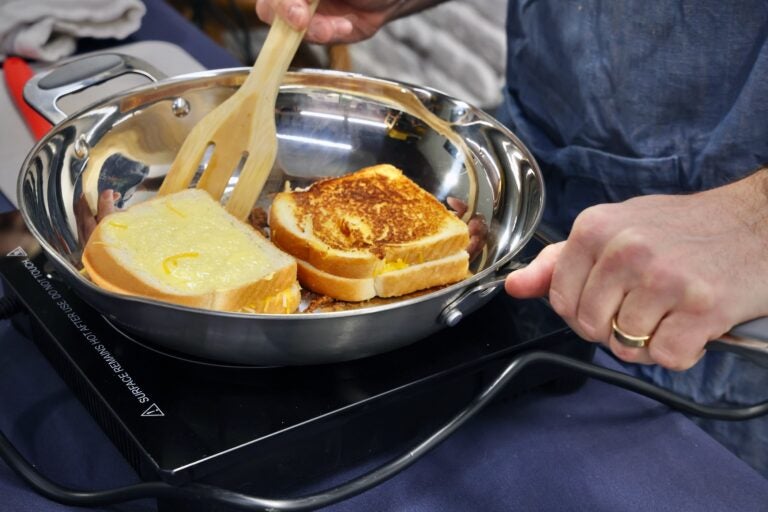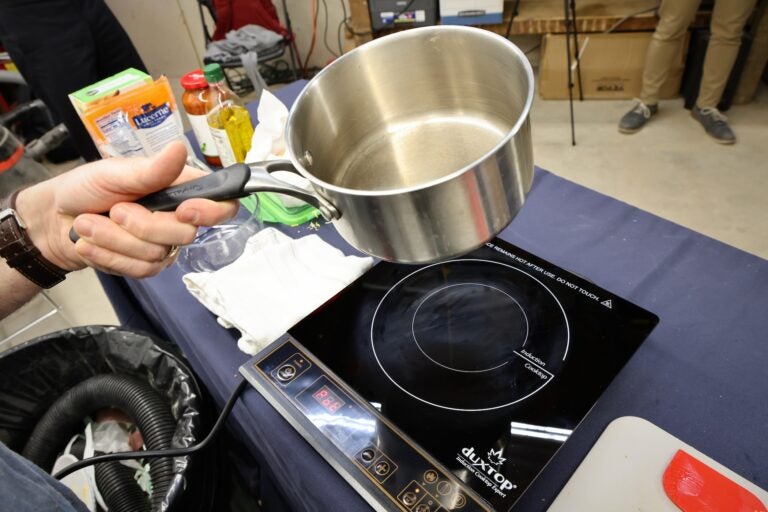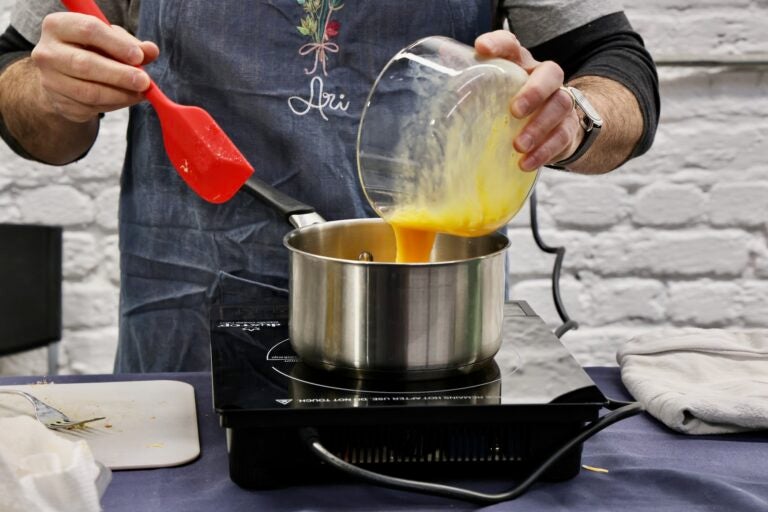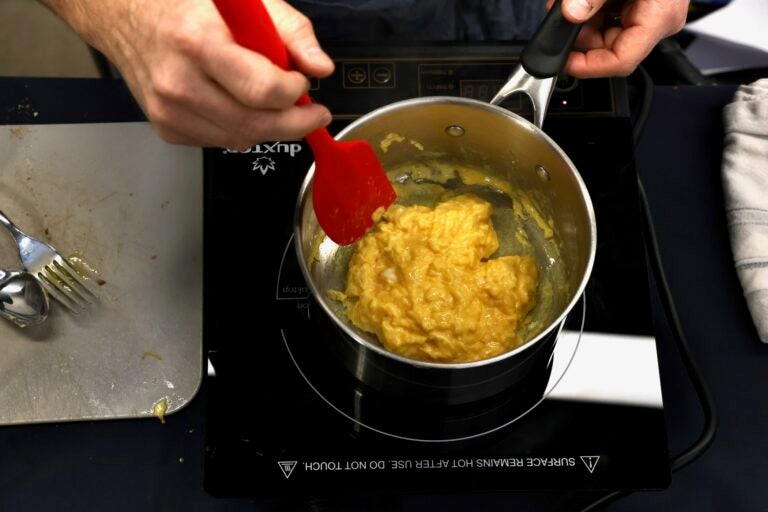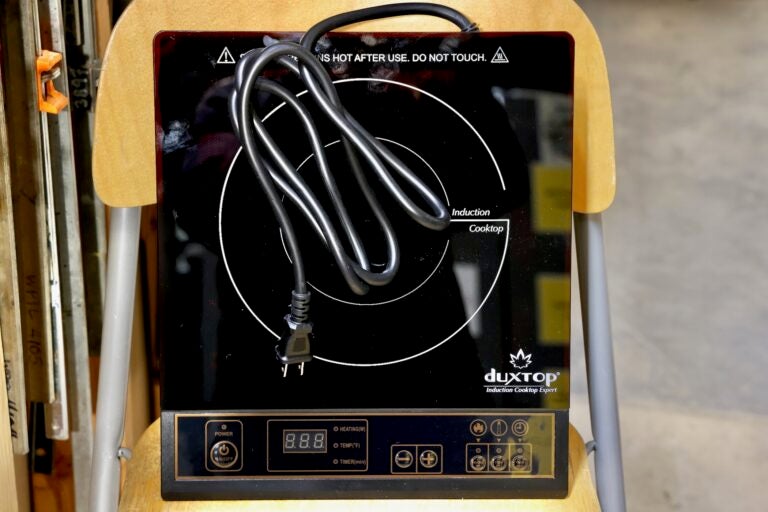West Philly Tool Library lets you ‘test-drive’ a gas-less cooktop before taking the plunge
Induction stoves are healthier and more efficient than gas, but they can be pricey. This tool offers an affordable way to try them out.
Listen 1:49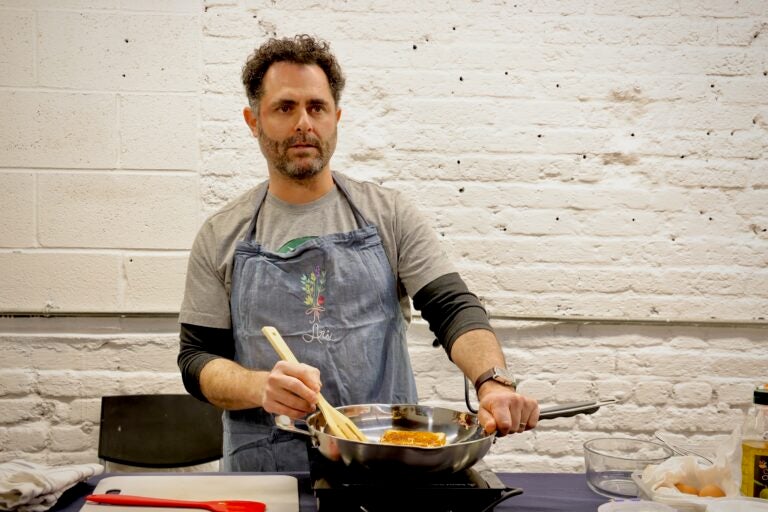
Chef Ari Miller makes grilled cheese sandwiches during a demonstration of an induction cooktop at the West Philly Tool Library. (Emma Lee/WHYY)
Have a question about Philly’s neighborhoods or the systems that shape them? PlanPhilly reporters want to hear from you! Ask us a question or send us a story idea you think we should cover.
The West Philly Tool Library is renting out two new portable induction cooktops, so households can try out the gas-free technology at home before investing in a new stove.
“You’re not going to go out and buy a huge [induction] stove to replace your current cooking setup, just to try it out and see,” said Jason Sanders, director of the West Philly Tool Library, a nonprofit in the Cedar Park neighborhood that rents out thousands of tools for DIY home renovations and auto repairs. “This is a very affordable way to do that.”
Induction cooktops use an electromagnetic field to create heat within cookware. They’re a more efficient and cleaner alternative to gas stoves, which release unhealthy pollutants into homes and contribute to climate change.
PennEnvironment, an environmental advocacy nonprofit, donated the cooktops to the West Philly Tool Library.
“These donations will allow more people to test-drive these great appliances and build public support and affinity for transitioning towards this cleaner technology,” said Belle Sherwood, PennEnvironment Research & Policy Center’s climate associate.
How to rent an induction cooktop from the West Philly Tool Library
The West Philly Tool Library on South 47th Street offers over 3,500 tools for rent for landscaping, auto repair and home maintenance and improvements.
To borrow tools from the library, you’ll need a membership. These are priced on a sliding scale from $20 to $150 per year, according to a member’s annual income. You can sign up online.
The induction cooktop models available to rent are Duxtop 1800-watt portable countertop burners, which sell for around $63 on Amazon. Full induction ranges, including attached ovens, typically cost between $1,000 and $5,500.
Not every pot or pan will work on an induction stove, and the Tool Library does not have induction-compatible cookware to rent out. But you may already have pots and pans that work at home.
Any pot or pan with a bottom that a household magnet sticks to will work on an induction stove. Cast iron pans are induction-compatible.
Electric stoves are healthier and better for the climate than gas
Gas stoves emit nitrogen dioxide, which can aggravate asthma and other respiratory diseases and may contribute to the development of asthma. Gas stoves have also been found to release benzene, a chemical linked to cancer.
One study estimated roughly 13% of childhood asthma cases in the U.S. are attributable to gas stoves.
Dr. Dan Wolk, a doctor at Bryn Mawr Family Practice and member of Physicians for Social Responsibility Pennsylvania, uses an induction cooktop he bought on eBay for $50.
“Just one ER visit for a child can cost more than 50 bucks,” he said. “It pays for itself if your child has asthma.”
Decades ago, the natural gas industry used tactics similar to those of the tobacco industry to cast doubt on growing evidence of the health risks of gas stoves, an NPR investigation found. The industry has continued to promote gas over electric stoves for cooking — including by paying Instagram influencers to praise gas ranges.
Induction and electric stoves are also better for the climate than their gas-powered counterparts.
When the electricity powering induction stoves is produced using fossil fuels, their use contributes to climate change. But electricity can also be produced using climate-friendly alternatives like wind, solar and nuclear. And gas stoves leak methane, a powerful greenhouse gas.
Induction stovetops are also more efficient than gas and conventional electric stoves, according to the U.S. Department of Energy.
“You’re using less energy, wasting less energy and saving money on your utility bills,” Sherwood said. “These appliances are a win-win for our health and our planet.”
What one Philly chef loves about induction stovetops
Philadelphia-based chef Ari Miller first heard about induction stoves as an alternative in restaurant kitchens that allow chefs to avoid installing expensive hoods.
“It sounded like, honestly, crazy technology cooking with magnets,” Miller said. “It wasn’t until I tried an induction plate … that it gave me the chance to realize that this is just another form of cooking. … It’s quite pleasant to use.”
Miller said using portable plug-in induction burners in his former restaurant allowed for more flexibility in the kitchen. When cooking for a crowd, portable induction burners can supplement a gas stove to create more cooking space.
Induction stovetops can heat water faster than gas or conventional electric. They can also heat to a specified temperature, allowing for more precision.
“It’s actually kind of neat because if boiling water, … you can set your induction burner to 212 [degrees Fahrenheit], and it’s going to use the right amount of electricity to just get us there,” Miller said.
Things that may take getting used to if you’re switching from gas
While Miller says he prefers cooking on an induction stovetop to a gas range, he admits there may be a bit of a learning curve if you’re accustomed to gas.
“It takes a little bit of adjustment and getting used to for sure, just like anything else in your kitchen, anytime you have a new tool,” Miller said.
For example, an induction burner will only heat a pan when the pan is directly touching the burner.
“If the metal isn’t touching the magnet, then there’s no heat to transfer,” Miller said.
Also, induction burners heat from the center out, creating a “hotspot” in the center of the pan, Miller said. This only tends to be an issue when cooking large volumes and doing something that requires even heating throughout a large piece of cookware, like searing.
“I would [rather] cook something in two batches instead of one batch and then breathe in noxious poisonous gas,” he said. “To me, that’s a worthwhile trade.”
Rebates could be coming to lower the cost of induction stoves
Pennsylvania plans to roll out a federally funded rebate program this year. The program would offer up to $840 in rebates to low—to moderate-income households to reduce the cost of Energy Star-rated induction stoves and other electric and energy-efficient appliances.
The state’s program, funded by Biden’s Inflation Reduction Act, was approved in the final days of the Biden Administration. President Donald Trump ordered agencies to freeze funding under the law on his first day in office. Experts have said it would be difficult for the new administration to legally claw back money already under contract, but recipients of other grants have reported issues accessing funds at some points.
Trump has accused Democrats of wanting to “take away” gas stoves. In reality, the legislation he was referring to set efficiency standards.
The U.S. Department of Energy did not respond to questions about the rebate funding. A spokesperson told the Washington Post the agency “is conducting a department-wide review, which includes funding such as grants and loans, to ensure all activities are consistent with President Trump’s executive orders and priorities.”

Subscribe to PlanPhilly
WHYY is your source for fact-based, in-depth journalism and information. As a nonprofit organization, we rely on financial support from readers like you. Please give today.





